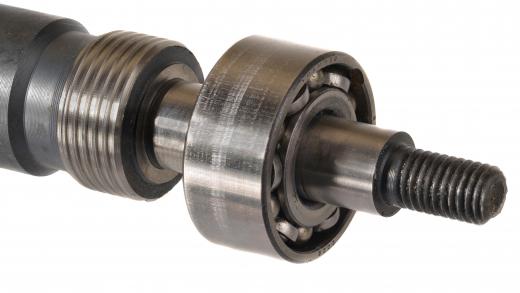A shaft bearing is a mechanical component used to support an applied load, and allow rotational or sliding motion between two or more parts. Shaft bearings are widely used in mechanical and industrial applications, including automotive, aerospace, industrial machinery, and many more. There are many different types of shaft bearings, ranging from simple, inexpensive bearings that provide sliding contact, to high-precision bearings for maintaining very precise, mechanical tolerances and high reliability.
One common type of shaft bearing is known as the plain bearing. This simple and low cost bearing consists of a cylindrical sleeve made of a low friction material, such as bronze, plastic, or graphite, which allows a shaft to rotate, or slide, inside the sleeve. The contact area between the inside diameter of the sleeve and shaft is referred to as the bearing surface. Plain bearings are often used for mechanical applications that do not require high tolerances with lubrication to prolong their usable life. The surface contact between the outside diameter of the shaft and inside diameter of the sleeve in plain bearings makes them prone to wear over time, and may limit their usable life.

Another common shaft bearing is known as a rolling-element bearing. This type uses spheres or small cylinders that rotate, or roll, between a shaft and the mating parts to reduce friction and allow much tighter mechanical tolerances. The three main components of a rolling-element bearing are the inner race, which contains the hole that the shaft slides into; the outer race, which is usually mounted inside a housing; and the rolling, mechanical components located between the inner and outer races. A ball bearing is a common type of shaft bearing, with spheres that spin between the inner and outer races to reduce friction. Rolling element bearings can be purchased with special features, like seals and shields, that protect the internal components from contamination that could cause mechanical damage to the bearing.
A shaft bearing can be purchased in a wide range of sizes — in both standard and metric measurements — and there are various types, with varying levels of precision. Selecting the appropriate bearing for a specific application is generally based on several considerations, such as the rotational speed of operation, the type of applied loads, the size, weight, costs, and safety requirements. Higher precision shaft bearings are often more expensive, but provide much higher reliability and extended service intervals. Bearing manufacturers produce bearings to standardized tolerances established by international standards organizations, with consideration for the proper tolerances for the shaft and housing to ensure proper operation.
